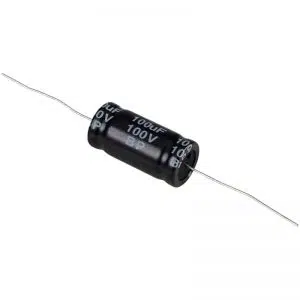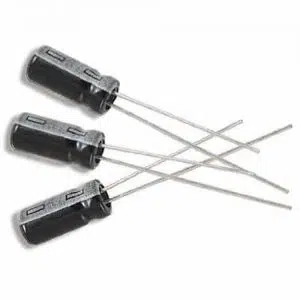The sound might deteriorate when you are using an amplifier, and this could cause the speaker to bottom out.
This will ruin the general quality of the sound coming from your speakers; thus, you need a way to correct such errors.
A capacitor could be what you need to get the best sound from your speaker. A capacitor will choke out the lower frequencies and allow only high frequencies to pass.
This will ensure your amp gets frequencies that your speaker can deal with; hence your audio will be of better quality.
There are many options for capacitors in the market, and they all differ significantly in terms of specs.
Choosing your speaker crossover might not be that simple, and choosing the wrong one could spell disaster since the whole system will depend on the capacitors.
A crossover without a capacitor might make the sound from your speaker awful. Now that we have established why you need to get a capacitor for your crossover, here is a list of the best capacitors in the market for you to select the best one;
Best Capacitor For Speaker Crossover
1. OCR 24 Value Electrolytic Capacitors
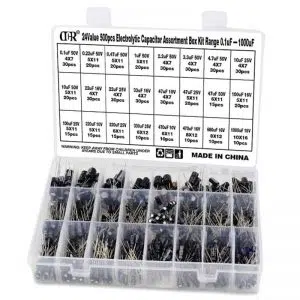
This set is an option for a user looking for a flexible choice that will give them many capacitors to work with on different electronics.
Specifications
- Brand: OCR
- Material: Electrolytic
- Weight: 10.9 ounces
Features
This set contains 24 types of capacitors to choose from to ensure that you get the one that perfectly suits your needs.
The set has a total of 500 pieces. This is an advantage because you can choose the best capacitor, and should it get damaged, you will have plenty of options to replace it.
This high number makes this option good for a repair professional that deals with many different products.
It can comfortably work with the capacitance of between 0.1 microfarads to 100 picofarads. This makes it flexible since it can operate with a wide range of amplifiers and speakers if you choose the right capacitor from the set.
The capacitors come in a sturdy box to keep all of them together and prevent losses. Capacitors can be a danger, especially to children that might put them in the mouth and get choked; thus, the box is a big help.
The box is assorted to help with the organization of the capacitors. There are 500 pieces in one set; thus, finding a capacitor could be difficult if the box didn’t separate them for you.
All the capacitors in this set are marked and labeled to make them easier for you to pick out. This will reduce the risk of installing the wrong capacitor and damaging the amp or speakers in your system.
2. Parts Express 100µF Electrolytic Capacitor
This capacitor is a heavy-duty and durable option for users looking for a long-term solution for their sound systems.
Specifications
- Brand: Parts Express
- Material: Electrolytic
- Weight: 0.64 Ounces
Features
This is a product that was specifically designed for crossovers. It, therefore, means that all the details in it are brought together to produce the best quality possible when balancing your frequencies.
The Parts Express capacitor is 2.12 by 2 by 0.4 inches, making it a convenient size because it is big enough to work comfortably. Still, it’s also small to avoid compromising your system’s appearance.
This capacitor is non-polarized; this means that it can be connected either way in the circuit. This is a big advantage, especially for beginners who are not comfortable with the electronic circuits, so that they could mess up with a polarized capacitor.
It can operate comfortably with a voltage of up to 100V. This makes it usable for almost all speakers meant for home use and even larger-scale commercial use. You can use powerful amps without risking frying the capacitor.
This product is the best choice to make connections on neutral AC lines and provide a low amount of impedance to match your amp and speaker’s performances.
This is a cheap product going at around $7 on Amazon, making it a convenient choice for any user.
3. BOJACK 24 Value Aluminum Electrolytic Capacitor
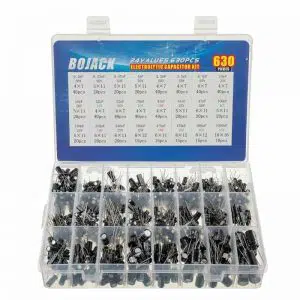
This is a durable and high-performance Aluminum capacitor for an extensive list of uses on any electrical equipment or audio system.
Specifications
- Brand: BOJACK
- Material: Electrolytic
- Weight: 13.62 Ounces
Features
This set contains 24 types of capacitors ranging within 10V, 16V, 25V, and 50V, making it a good choice for a professional.
It will give you many options to repair and a vast number of equipment with different power ratings.
If you are using it for your equipment, then you can select the capacitor that will best suit your needs since there are many options in the set.
The capacitors vary in capacitance between 0.1 microfarads to 1000 microfarads to give you 630 pieces in the set.
This ensures you have a capacitance that will suit any speaker or amplifier you could want to use.
Each capacitor has a marked value to make it easy for the user to select the one that suits the sound system best.
This labeling will also prevent mix-ups during storage and connection of bad capacitors, damaging equipment.
This is a good option for a beginner since it is a suitable option for a do-it-yourself setup. The simplicity and size of these capacitors make it possible to use them without complicated electrical equipment that you would need with some more complex capacitors.
The capacitors in this set are flexible in use; you can connect it to an LCD, crossover, microwave, or stereo, which is almost all the electronics you would find in an average home. So you spend once and get a fix for all your electronics.
These capacitors range between temperatures of -400C and 1050C in endurance. This wide range ensures it will perform optimally and last long since most sound systems don’t get hot enough to damage the capacitors.
4. PAC BB-6PR Pair Bass Blocker
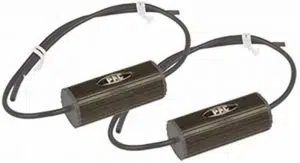
This is a product from a reputable company with many positive reviews from its current users, and it is guaranteed to serve you well.
Specifications
- Brand: PAC
- Weight: 1.23 Ounces
Features
The capacitors have a black-coded lead to make them easier to identify so that you install the right capacitor.
They can deal with input power of up to 50 watts which makes them usable for amplifiers and speakers for most home systems without the risk of overloading them.
It comes with heat shrink tubing and high-quality wire leads that are easy to understand. This makes installation easy even for beginners, and it will reduce the risk of wrong connections that could damage the amp and fry the capacitor.
The capacitors come as a pair to give you more connection options. You can use them in different systems or integrate them into one system to increase performance. Still, it will be repetitive without any significant difference.
It blocks a wide range of frequencies depending on the resistance; at 4 ohms, it will block all frequencies below 5600Hz and at 8 ohms, it will block all frequencies below 2800 Hz.
This range allows you to use your speakers to the maximum potential without bottoming them out.
The flexibility in terms of frequencies that it can block gives the user some freedom to choose to listen to.
Depending on the power of their equipment, they could allow more or fewer frequencies to pass through.
This capacitor was designed to increase the power handling and performance efficiency of your amplifier.
It does this by eliminating exceedingly high frequencies to reduce the workload on your amplifier and give better performance.
5. E-Projects Radial Electrolytic Capacitor
This is an ideal capacitor for a user that needs an easy-to-connect capacitor for a small yet high-performing sound system.
Specifications
- Brands: E-Projects
- Weight: 0.28 Ounces
- Material: Electrolytic
Features
This capacitor has a capacitance of 100 microfarads which makes it usable for most amps and speakers that you would use in a domestic environment such as a house or a car.
It can support a maximum voltage of 50 volts which makes it a good choice for standard speakers.
You might have to look for a different capacitor if you are using a very powerful amp that needs more than 50 V since this capacitor will not work.
This capacitor can endure a maximum temperature of 1050C and still give optimal performance. This makes it a good choice for someone looking for a permanent option since it can last long, even in a system under a lot of pressure, and it heats up.
Several well-known manufacturers manufacture the E-Projects capacitor. This gives the user a wider range of options to choose from depending on the manufacturer you feel most comfortable with.
The capacitor is radial. This means that both its nodes come out from one side, and this is a feature that gives it a wider range of uses.
You can use it in small electronics that other capacitors would not fit or larger electronics and still get high performance.
6. PAC BB-2PR Bass Blocker
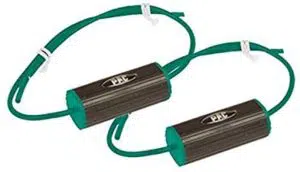
PAC is one of the best companies in the manufacture of electronic components, and this is another product that has held up well in the market and will serve you well.
Specifications
- Brands: PAC
- Weight: 1.13 Ounces
- Material: Electrolytic
Features
It has a filter to remove extremely high frequencies from the source to prevent your speaker from bottoming out, which will make it last longer. This will also improve the general audio quality of your speaker to give a better experience.
It is easy to install, so you can do it yourself, saving you the effort and money of looking for an expert to repair.
It is specifically designed for 6 inches and 6.5-inch speakers, the best for cars or small houses.
It is a bass blocker that is good for your speaker; too much bass could mess up your speakers and damage the voice coil, which will ruin the quality of sound.
It blocks all frequencies below 600Hz at 4 ohms and all frequencies below 300 Hz at 8 ohms. This keeps out all the harmful frequencies to prevent bottoming out, but it also accounts for powerful speakers to give them more frequencies to work with.
Buying Guide For The Best Capacitor For Speaker Crossover
The capacitors are also known as condensers. The capacitor is an essential component in any music system.
The capacitor is a passive electrical component.
It stores electrical charge in two different plates or electrodes. Unlike batteries, the capacitors don’t charge the electrodes using a chemical reaction. Instead, they need the incoming current.
Despite its size, the capacitor is very powerful. Plus, it can discharge the electrical current it stores pretty quickly.
In addition to this, the capacitor has many uses: filtering frequencies, signal processing, evening out a power supply, and signal decoupling and coupling.
Above, we have listed the best capacitors for crossover speakers. But that is not enough when it comes to making a buying decision. There are several important factors other than price and design that you need to look into.
This section will explore the key considerations that you need to consider before making the final decision on the capacitor to buy.
How To Select A Capacitor – Important Factors
Capacitance
If you’ve been dealing with electricity and electrical component, I’m sure you’ve heard about capacitance. It’s the capacitor’s electrical property.
The capacitance is the first need you need to consider when selecting a capacitor. The amount of capacitance you require will depend on the size and complexity of your application.
You will surely need a larger capacitance capacitor if you want to filter output a rectified voltage.
However, if you only intend to filter signal noise in a small signal circuit, the capacitor with a small capacitance will work perfectly.
Therefore you need to know your application. This will enable you to the amount of capacitance you need. However, you will have to do some calculations to be specific.
Tolerance
Tolerance is another critical factor to consider after the capacitance. If you have a complex or critical application, you should go for the small tolerance capacitor.
The capacitor has several tolerance ratings such as 20%, 10%, and 5%. So, it’s on you to select the right one for your speaker crossover.
However, you should note that a capacitor with lower tolerance is expensive than a higher tolerance one.
Capacitor Current Rating
Regarding the capacitor current rating, ripple current must be mentioned if you are not in the electronics field or do not love it. Then you might not be familiar with the term ripple current.
The ripple current is undoubtedly the current passing through the capacitor. In most cases, the capacitor that has been installed across a DC voltage line has no flowing current.
But if there is a slight fluctuation in voltage or the voltage across the capacitor is not pure DC, it will cause ripple current.
However, if the speaker crossover circuit is lower power, do not worry about ripple current ratings. The ripple current is quite critical in circuits that the capacitor has the role of filtering pulsating DC.
Capacitor Voltage Rating
You need to consider the voltage rating of the capacitor during selection. It’s because voltage stress does damage the capacitor.
Therefore you have to know the voltage level of the speaker crossover. This will help you select the suitable capacitor that will serve you for years.
If you blindly buy the capacitor, you will sure make several repairs and replacements. I can guarantee you that a capacitor installed in a circuit with a higher voltage rating will not survive a day.
Therefore for a speaker crossover with 10V, select a capacitor with a minimum voltage rating of 13.33V. This is just the best ratio example I can offer.
However, there is no such voltage rating in capacitors. Therefore the best one to go for a 10V circuit is the 16V capacitor.
There are other ratings of 20V or 25V. So, in all the circuits, you should always ensure that the capacitor’s voltage rating is higher than the circuit’s.
The Operating Temperature Of The Speaker Crossover
It would be best if you also put the environmental factors into consideration when choosing a capacitor. The capacitors come with different temperature ratings they can withstand.
Let me briefly explain how it works and how it should be used in different temperatures. If you intend to use the product in an environment with 100’C, then do not use a capacitor with a lower rating like 85’C.
This applies even in an environment with minimum temperature. If you are in an environment with -30’C, do not go for a capacitor that can withstand -20’C temperature.
The temperature specification rating is so straightforward. You should, however, note that ripple leads to internal heating.
This will lead to a thermal rise, which will be above the current environment temperature. Because of this, you should go for a capacitor that has more margins.
I mean, the margin between the environment temperature and the temperature the capacitor can withstand should be huge.
A quick example, if the environment’s temperature is 50’C, do not go for a capacitor with a rating of 50’C. Instead, go for one that has a rating of 100’C and above. The extra margin will be enough to withstand increased heat from internal heating.
Life Expectancy
Life expectancy is an easy-to-understand thing. You do not need to be an electrician to understand how this is an essential factor.
Life expectancy is the time the capacitor can stay healthy as it was designed. This is a very critical factor to consider when buying a capacitor.
Life expectancy is always an issue in electrolytic capacitors. You must evaluate this properly. It’s because most of them fail earlier before even the speaker’s crossover reaches the life cycle end.
The ceramic capacitors are excellent. It would be best if you did not worry a lot about their life expectancy. Mainly they fulfill their role if installed on the smaller circuit.
Although they still have a life limit but will undoubtedly serve the product well. However, you should know that the ripple current does shorten the capacitor’s life expectancy.
Therefore you have to control it constantly. Again the manufacturers do offer the calculations of capacitor’s life expectancy on the packaging. It would be best if you went through it to know the life expectancy of a particular product.
The Capacitor Type
The type of capacitor is another thing to consider. It’s more important now that you are dealing with music. It would be best to go for the capacitor type that will guarantee you clean and smooth music.
There are four types of capacitors. They are ceramic, film-foil, metalized film, and electrolytic capacitors.
When it comes to music, the film capacitor is the best. It will ensure that you get an acceptable sound quality.
Mounting Style and Physical Dimensions
It would be best if you also considered the mounting style and physical dimension when selecting the capacitor. There should be enough space to install the capacitor.
The electrolytic capacitors which have higher capacitance are bulky. It means they will need a larger space in the circuit.
The other type, known as a chip capacitor, is small but has low capacitance. It, however, does not need a lot of space.
In addition, there is the factor of mounting style. So, are you going to mount the capacitor through the hole or on the surface? These are some of the things you need to look into before purchasing a capacitor.
The Different Types Of Capacitor
The capacitor is quite helpful and is among the technical focus of the speaker crossover. There are three different types of capacitors.
These types are metalized film, film + foil, ceramic and electrolytic. They have already been mentioned in the guide on buying the best capacitor for a speaker crossover.
Here we go into more delicate details to help you understand a particular type’s various strengths and weaknesses. Let’s get into the nitty-gritty of the capacitors.
1. Film Capacitor
The film capacitor is the best for music. With this capacitor, you are guaranteed high-quality sound. By high quality, I mean smooth and crisp sound.
Under the film capacitor, we have two types of film capacitors. They are the metalized film capacitor and film + foil capacitor. Let’s find out the differences between these two types.
2. Metalized Film Capacitor
The metal film capacitors are small in size. It’s the components used that reduce its physical size. 99% pure aluminum is put in the place of discrete foil sheets.
In other metalized capacitors, manufacturers use other metals that are not aluminum. The metals are vapor-deposited on the dielectric material.
The dielectric material is found at the end of the capacitor. The end terminations of these capacitors are made of molten-metal spray. The molten metal is always fine.
3. Film and Foil Capacitor
The film and foil capacitors are the best choices for audio sound. The electrodes in this type of capacitor are unique.
They are made up of sheets with dielectric material and sheets of metal foil. Inside the capacitor, the electrodes do extend alternately.
4. Ceramic Capacitors
As the name suggests, the dielectric found in this capacitor is made up of ceramic material. During its manufacturing process, the capacitor is filled with alternating silver electrodes and ceramic.
For clarity, the electrodes found in ceramic capacitors are made of silver alloy. Despite all the mechanisms put in the making of this capacitor, it has some cons.
They are two but are pretty significant. The first one is that they have poor audio frequency response. It’s because of poor ESR and low IR (Insulation Resistance).
All these factors add more resistance to the circuit, causing an inadequate audio response. Another con is that ceramic capacitors do pick mechanical vibrations.
This is a prevalent thing in microphones. It then turns these mechanical vibrations into unwanted electrical signals.
In the end, it ends up causing audio distortion, which is known as micro-phonics. Because of these issues, the ceramic capacitor is not best in sound systems. You will not get the sound quality you deserve.
5. Electrolytic Capacitors
These types of capacitors are polarized. Like the battery, the electrolytic capacitors have both negative and positive terminals. The electrolytes in the electrolytic capacitor can be gel chemical, wet liquid, or solid polymer.
Because of these electrolytes, this capacitor does have a considerable capacitance. The pro of using this capacitor is that it is so affordable, plus it has a large capacitance in a small package.
However, anything that has an advantage must have disadvantages too. This capacitor also has some significant drawbacks.
The drawbacks include broad tolerances, large ESR (Equivalent Series Resistance), limited life, and low insulation resistance. Let’s look at the type of electrolytic capacitors.
6. Wet Electrolytic Capacitors
This is just a little breakdown to help you understand the capacitors well. I can assure you that by the end of this article you will have vast knowledge about capacitors.
Talking about wet electrolytic capacitors, they come in two distinct styles. The first one is plain foil, and the other is etched foil.
The difference between the etched foil and plain foil is noticeable. In etched foil, aluminum oxide is etched in foil. This makes the capacitor smaller in size but increases its surface area.
The electrolytic capacitors tend to have tremendous values. On the downside, the wet electrolytic capacitors do have low current capabilities.
A brief look at the plain foil; it does have two anodized plates that set up the polarity.
The plain foil style has a pro and a con. It has a small capacitance value and the ability to handle high currents.
7. Solid Polymer Electrolytic Capacitors
This one is easy to explain and understand. As its name suggests, this capacitor uses solid material in place of gel or liquid electrolyte.
Because of using solid electrolytes, you should avoid drying. This is one of the major things that lead to the failure of this type of capacitor.
Manganese is always used as the second terminal in this type of polymer. The solid polymer electrolytic capacitor has an advantage over the wet type.
It is better for the following reasons: low ESR and leakage current and better stability. The only disadvantage of this capacitor is that it can only be found in lower operating voltages.
The Functions Of A Capacitor In The Speaker
The capacitor has various useful functions. In this section, we are going to look at its role in the speaker comprehensively. However, before we continue, we have to find out what the speaker/ audio crossover is.
What Is an Audio Crossover?
The audio crossover is made up of several components. The function of the components is to separate the different audio spectrum parts. Plus, the audio crossover does send signals to the particular speakers and drivers.
Here is how the audio crossover works by sending signals. The crossover sends high definition signals to the tweeter, the midrange signals to midrange speakers, and finally, the bass signals to the woofer.
What is the Importance of The Speaker Crossover?
Generally, the frequency range of the audio is always between 40Hz to 20 kHz. This frequency is too much for handling by one speaker and driver.
If you direct this entire spectrum to one speaker or driver, it will distort the sound. The drivers of a speaker are designed for a particular signal or audio frequency range.
By any chance, if you operate it outside this range, it will lead to damage to both the speaker and driver. If there won’t be any damage, I can assure you that the distortion will be extreme.
Nobody is comfortable with distorted sound. Here is where the crossovers come in handy. The crossover contains capacitors, inductors, and resistors.
Each of these components has a specific function that is tied to frequency. In the high pass filter, all the low and mid-range frequencies are blocked.
The crossover is always put between the speaker and the amplifier. In addition, they do not need external power to function.
The Functions Of The Capacitor In Speakers
Many people do not know the functions of the capacitor until it is damaged. This component has many uses like signal processing, signal decoupling and coupling, frequency filtering, and many more.
This uses mainly applies to the audio technology field. In addition, the capacitors offer steady signals to the loudspeaker. Mostly this happens when the bass level increases rapidly.
There might not be enough voltage to power the speaker during this instance. The capacitor comes in and offers a short-term solution by lending out its little energy. In the hi-fi area, the capacitor helps in dealing with rapid changes in voltage.
1. Ensures Voltage Flow
This is also referred to as evening out the voltage. It’s a common term among the electrician and electronic enthusiasts. In amplifiers, one of the significant roles of the capacitor is ensuring there is an even flow of voltage.
If you do not use a capacitor in your music system, you will experience an undefined power supply. You should know that the system cannot process this type of power.
The voltage will lead to a horrible quality sound that is not clear. It’s because each time your system peaks, it will be falling back to zero volts.
The role of the capacitor is to prevent such falls. It covers the gap by providing its saved energy. The great thing is that the capacitor can never run out of charge.
It charges when the system is on its peaks and discharges when there is a gap. With this pattern, the capacitor will always have power. If you notice any inefficiency in regards to the capacitor, then it might be damaged.
2. Amplification Stages Coupling
I’m just amazed by the many roles that this component plays. The coupling of two amplification stages is yet another significant role of this electrical component.
Ideally, it’s not the DC voltage but the AC voltage transmitted from preamp to amp. With the capacitor in the system, this is easily and arranged.
It will do the selection job. Let me explain this in more detail. If the battery is fully charged, the capacitor prevents further direct current from flowing through.
However, it allows the flow of alternating current to continue. Certain capacitors do the function of blocking AC from DC voltage.
This type of capacitor is referred to as a coupling capacitor. The coupling capacitor is commonly used in microphones.
It blocks the DC signals from mixing with the signal being recorded. The DC signal is critical in powering the microphone. However, in audio recording, the only signal needed is the AC signal.
Understanding The Capacitor Value
When it comes to the capacitor, understanding the value is essential. There is a simple thing that you need to know. That the charge a capacitor is capable of carrying depends on its size.
If a capacitor is big, it will carry a more significant charge and vice versa. The values of the capacitors are in volts (V) and farad (F). The farad value stands for capacitance or capacitance rating.
The farad helps us to know the amount of energy that a capacitor has in a specific voltage. One volt can undoubtedly charge a capacitor that has a capacity of one farad.
The load of the capacitor is also given by using the voltage rating. The load is simply the maximum amount of voltage the capacitor is exposed to before damaging.
Under the capacitor value, there are several things you need to understand. Most manufactures include these details in their packaging.
What Damages The Capacitor?
The capacitor breaks can break down because of various factors. The first sign that a capacitor has broken down is white smoke coming from the amplifier.
This is undoubtedly a sign of a damaged capacitor. Some of the things that damage the capacitor are. A capacitor can fail if you use it in an environment that has extremely hot temperatures of more than 80 degrees.
Other than extreme temperatures, the capacitor can be damaged by other things. Many times the issue stems up from dielectric. This is the material that is between the insulating materials.
The dielectric can is usually made of a water mixture. If it dries out, the capacitor will undoubtedly stop working, or it can cause a short circuit.
It’s hard to know the life expectancy of the capacitor. Some can work for up to five years, while some do not make even three. You can, however, consult a professional if you want more details about a specific capacitor.
Conclusion
A capacitor can be a good addition to your sound system if you install it correctly. There are a lot of options for users looking for capacitors, single capacitors, and sets. If you have a home system you need to repair; then you can use a single capacitor.
If running a repair shop, you can get a set with more options to select from. Getting the right capacitor will ensure you get the best sound quality, and your equipment will last longer.




